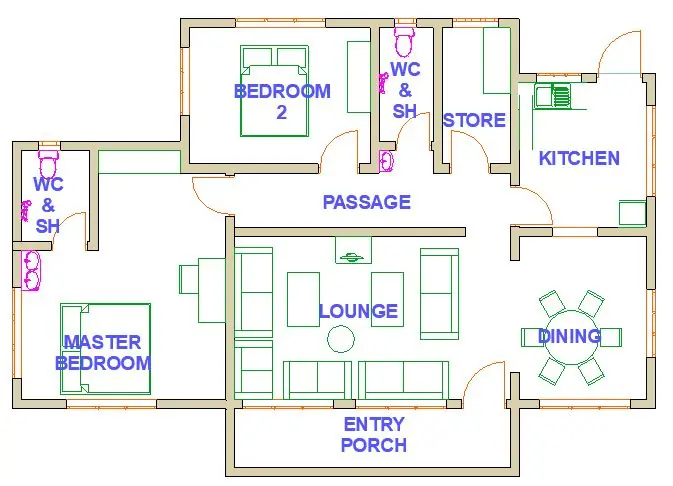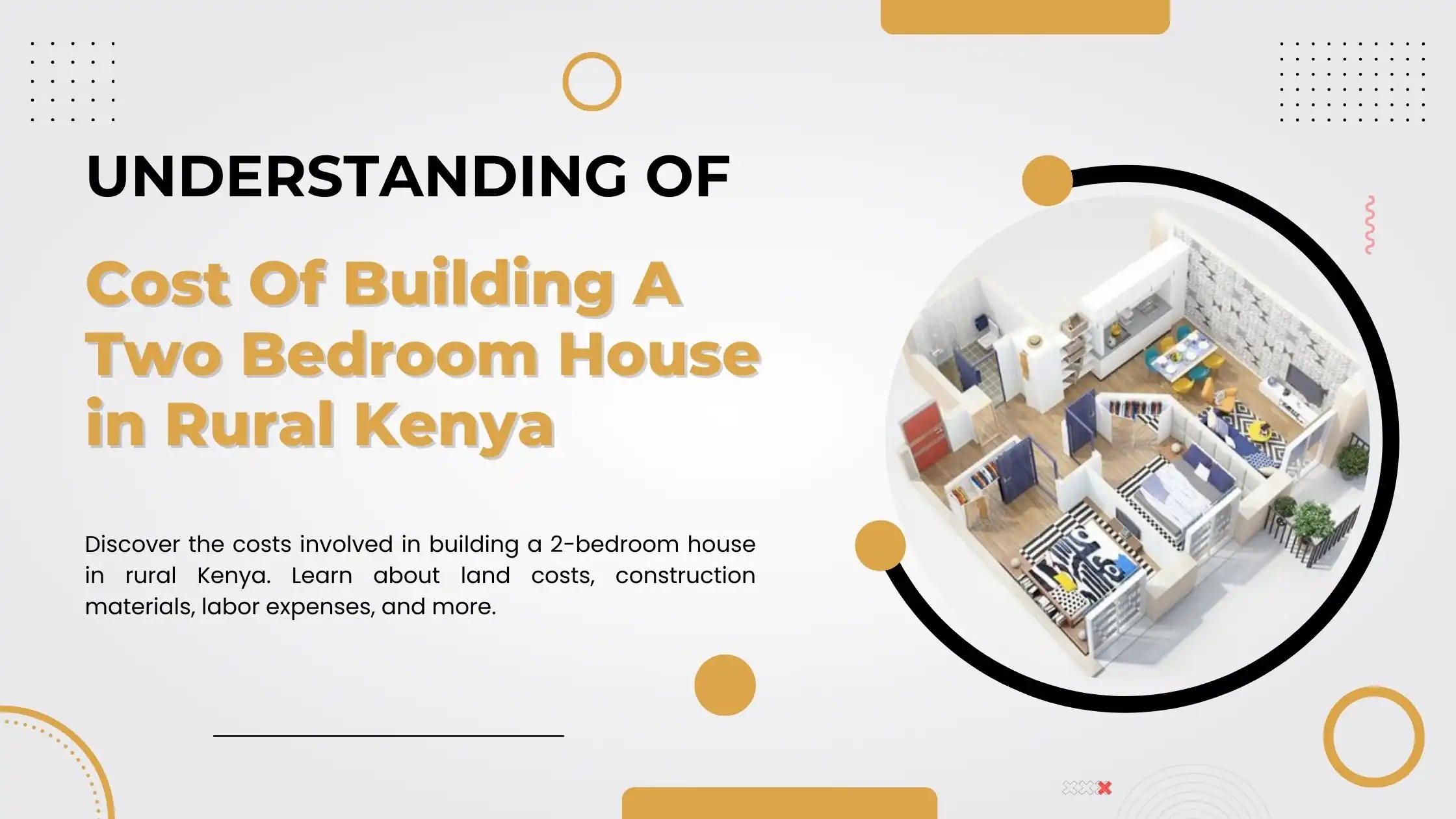Understanding The Cost Of Building A Two Bedroom House in Rural Kenya
Introduction to The Cost of Building A Two Bedroom House in Rural Kenya
There is a trend of building homes in rural Kenya. The reason is that land is cheaper and costs less to build than cities. Many Kenyans consider this a good way to own property without high expenses. This is especially common for those preparing for retirement or seeking investment options.
- Introduction to The Cost of Building A Two Bedroom House in Rural Kenya
- Overview of A Typical 2 Bedroom House Design
- Get Your Cost Estimate
- Common Construction Styles in Rural Kenya
- Land Costs and Acquisition in Rural Kenya
- Key Construction Costs for a 2 Bedroom House
- Labor Costs in Rural Kenya
- Materials Cost Breakdown
- Additional Costs and Considerations
- 4. Contingency Budget
- Financing Options for Building a 2-Bedroom House in RuralKenya
- Conclusion
- Frequently Asked Questions
Overview of A Typical 2 Bedroom House Design
A normal 2-bedroom house in rural Kenya usually has a simple and practical design. The house usually contains:

- Two Bedrooms: Often on opposite sides of the house for privacy.
- Living Room: Located in the center, It’s the main gathering area for family activities.
- Kitchen: This can be a separate room or an open-plan space.
- Bathroom: Generally one shared bathroom, located near the bedrooms for easy
access. - Optional Veranda: Many rural homes have a small veranda for relaxing and enjoying
outside. - Square Footage: The average area of a 2-bedroom house in rural Kenya is between
700 to 900 square feet. This size is usually enough for comfortable living without high
expenses.
Get Your Cost Estimate
Common Construction Styles in Rural Kenya
1. Traditional Materials
Houses often utilize local materials like mud, thatch, and timber. These are cost-efficient and work well with the environment.
2. Brick and Mortar
Brick houses are common and strong. Bricks are made locally and are not costly, offering good insulation from weather changes.
3. Stone Construction
In regions where stone is easy to find, homes are built with stone blocks. This method is strong and insulates well.
4. Concrete Blocks
Concrete blocks are used for their strength and lifespan.
Land Costs and Acquisition in Rural Kenya
1. Cost of land in Rural Kenya
In rural Kenya, land costs less than in cities, making it a good choice for building homes. Land prices vary depending on location, accessibility etc. Price of Rural Land:- Ksh 100,000 — kshs 500,000 per acre (may vary).
2. Plot size for a 2 Bedroom House
A 50 by 100 feet plot is sufficient for a two-bedroom house. There is just enough space around the house to still have a garden or outdoor area
3. Land Preparation Costs
Before building starts, land must be prepared. This means clearing plants, leveling the ground, and making basic access like roads. Costs for land preparation can range from Ksh 50,000 to Ksh 150,000.
Key Construction Costs for a 2 Bedroom House
Building a 2-bedroom house in rural Kenya includes several main construction costs. Here are the key expenses:
1. Foundation Costs
The foundation is vital for the house’s stability. Costs can differ based on soil type and method used (like slab or strip foundation). Generally, foundation costs range from Ksh 80,000 to Ksh 150,000 ($750 to $1,400). This includes Excavation, materials like concrete and steel, and labor are all necessary.
2. Walling
Usually, walling costs about Ksh 100,000 to Ksh 200,000 ($900 to $1,800). This includes materials, mortar, and labor.
3. Roofing
Roofing prices usually fall between Ksh 70,000 and Ksh 150,000 ($650 to $1,400). This covers materials and labor. A good roof construction is key for lasting quality and energy saving
4. Doors and Windows
For doors and windows, expect to pay Ksh 50,000 to Ksh 100,000 ($450 to $900)on average. This includes materials, installation, and labor. Good quality doors and windows improve security and comfort in the house.
5. Plumbing and Electrical Work
Costs for plumbing and electrical work can range from Ksh 80,000 to Ksh 150,000 ($750 to $1,400). This includes materials and labor, ensuring that everything follows safety rules.
Labor Costs in Rural Kenya
In rural Kenya, labor costs are a big part of construction expenses. Labor prices can change based on skill level and the area where the building is done.
A. Skilled vs Unskilled Labor
A skilled labor can cost between Ksh 500 to Ksh 1,000 per day ($4.50-$9). This includes unskilled labor (helpers digging, mixing cement and moving materials) Ksh 300– ksh700 ($2.70-$6.30/day).
B. Total Labor Costs
Labor costs for an average project might be between Ksh 200,000 — Ksh 500,000 ($1,800–$4.5k) as a combined rate of skilled and unskilled labor
C. Regional Labor Variations
Labor costs can differ by region due to living costs and worker availability. For instance, labor in remote places may be lower because of fewer job options. In areas closer to urban areas, costs may be higher due to more demand. It’s important to check and consider these regional differences when planning construction.
Materials Cost Breakdown
| Cost Factor | Estimated Cost (KES) |
|---|---|
| Land Acquisition | 100,000 – 500,000 |
| Land Preparation | 50,000 – 150,000 |
| Foundation | 80,000 – 150,000 |
| Walling | 100,000 – 200,000 |
| Roofing | 70,000 – 150,000 |
| Doors and Windows | 50,000 – 100,000 |
| Plumbing and Electrical | 80,000 – 150,000 |
| Finishing | 100,000 – 300,000 |
| Total Cost | 830,000 – 1,530,000 |
1. Cement, Sand and Gravel
In 2024, a 50kg bag of cement in Kenya costs between KSh 720 and KSh 1,250, depending on the brand and type.
Sand and gravel are needed for concrete and mortar. Sand costs about KSh 2,000 per tonne in Kenya. Gravel also referred to as hardcore or ballast, is around KSh 1,700 per tonne. Prices can differ based on location and quality.
2. Bricks
Walls are generally built with bricks. A brick is a block or bar made of clay, lime stone, concrete and sand that are dried by water. Whether you choose bricks or concrete blocks, the costs can range from Ksh 50,000 to Ksh 150,000 ($330 to $1,000) for a 2-bedroom house. The final price depends on the quantity of bricks your project
requires.
3. Steel and Reinforcement
The cost of steel bars and other reinforcements for the foundation and walls will typicallrange from Ksh 100,000 to Ksh 200,000 ($665 to $1,330). Of course this mechanic is determined by the diameter and quality of steel.
4. Roofing Materials
Tiles, thatches and shingles are popular roofing materials. They cannot be priced accurately when it comes to their kind or quality because they can range from $ 5-500+ each. For instance, the corrugated iron sheets are ranging from KSh 50 to KSh100 per square meter. KSh 200- Ksh500 per square metre Floor Tiles
5. Finishing Materials
In other words, most interior and exterior building that require finishing materials. This consists of paint, tiles used in several types of buildings such as houses and linings Prices fluctuate greatly depending on the quality.
A gallon of paint could go for KSh 1,500 to KSh 3,000 and floor tiles may cost anywhere between the range from around KSh 200 all up to a maximum price summing it per square meter based.
Additional Costs and Considerations
1. Interior Finishing
Interior finishing involves plastering, painting, tiling, and fixtures. These add to thebhouse’s look and usability. Average costs are between KSh 100,000 and KSh 300,000 ($900 to $2,700). Higher-quality finishes can raise this cost but improve durability and look.
2. Perimeter Wall and Landscaping
Average costs for perimeter walls are KSh 150,000 to KSh 400,000 ($1,350 to $3,600).
Landscaping, including trees and pathways, can add KSh 50,000 to KSh 100,000 ($450
to $900).
3. Furniture and Fittings
Furnishing requires buying furniture, appliances, and fittings. This can vary widely based on taste and quality. A basic setup might start at KSh 200,000 to KSh 500,000 ($1,800 to $4,500). This may cover essential items like beds, sofas, appliances, and fixtures.
4. Contingency Budget
Having a contingency budget helps with unexpected costs during construction. These could be due to material price changes, added labor costs, or site surprises. It is advisable to reserve about 10% to 20% of the total budget for this purpose. construction budget to cover unexpected costs. This financial reserve helps keep your project on schedule, avoiding financial difficulties.
Financing Options for Building a 2-Bedroom House in Rural
Kenya
1. Saccos and Chamas
Saccos and Chamas (community groups) are common funding sources for building projects. Saccos provides loans with low interest rates and flexible payment options. Being community-oriented, they simplify loan acquisition without extensive documentation. Conversely, Chamas enables members to combine resources to finance personal projects. Both avenues foster a supportive community. They may also be easier to access than typical bank loans.
2. Bank Loans
Banks in Kenya provide specific loans for construction. These loans are usually distributed in increments based on construction progress. Interest applies only to the drawn amount, making this a smart choice financially. Banks like Absa, and Stanbic Bank offer different loan amounts, interest rates, and repayment plans. Comparing different bank options is essential to find the best terms for you.
3. Government Programs
The Kenyan government offers programs to assist with affordable housing. These often include subsidies, low-interest loans, or grants for eligible individuals. Investigate these options to see if you can access governmental aid.
4. Self-Funding
Those with enough financial resources can consider self-funding. This means utilizing personal savings or income to cover construction costs. This avoids loan payments andinterests and ensures careful financial planning
Conclusion
Building a 2-bedroom house in rural Kenya entails costs such as land, foundation, walls, roofing, windows and doors, plumbing, electrical work, and finishing touches. Overall costs can vary due to factors like location, material selection, and labor availability.
Rural regions typically present lower land and labor costs, making them appealing for new home builders. Thorough budgeting, investigating different funding sources, and consulting skilled professionals, It are crucial to keep your project within financial limits. With proper planning and informed choices, you can realize your dream home affordably and satisfactorily.



